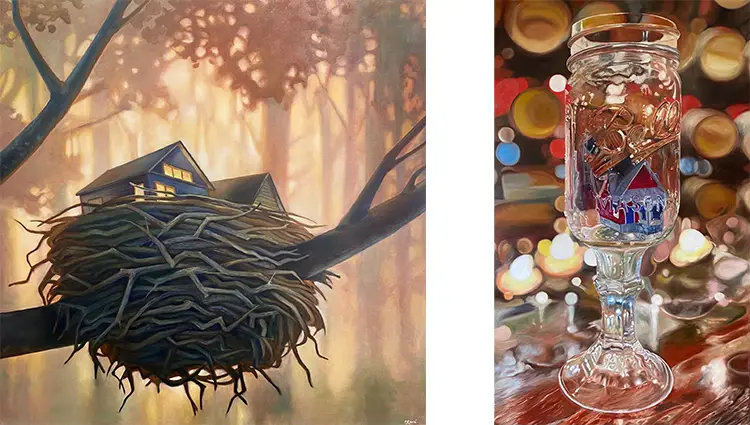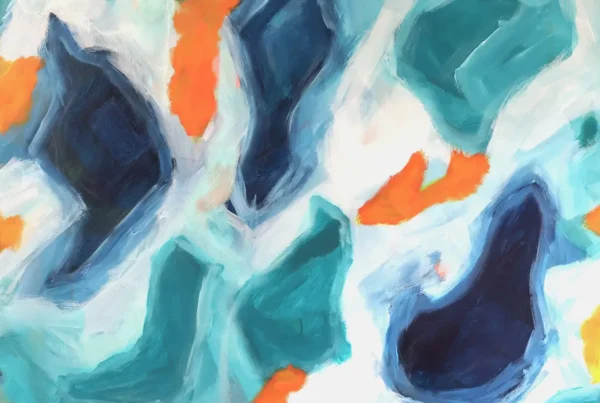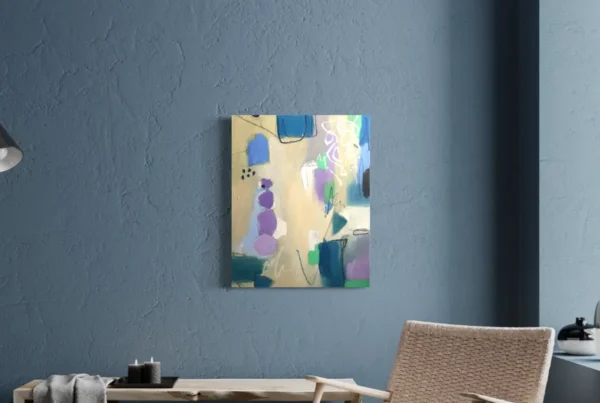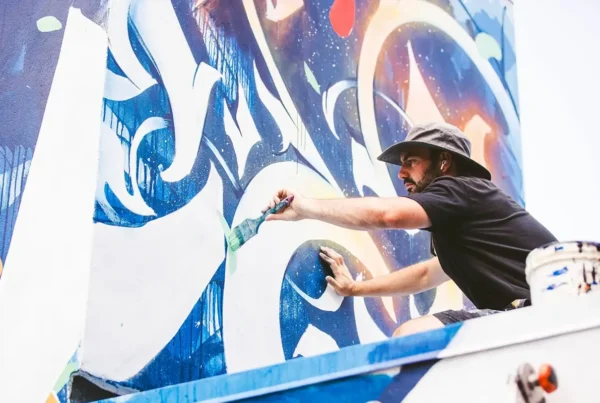“My work always has something to say about ‘home.’”
Reconstructing Reverie: From Rural Foundations to Fine Art
Crystal Rassi, a Canadian fine artist based in British Columbia’s lower mainland, intertwines personal narrative with evocative architectural imagery to produce deeply contemplative works of art. Her practice, rooted in reflections on home and memory, challenges the ordinary boundaries between realism and conceptual exploration. In addition to her full-time painting career, she teaches locally at community centers and mentors emerging artists through the online platform Mastrius, the largest mentorship community for creatives. Rassi’s commitment to artistic growth—both her own and others’—is inseparable from her broader exploration of belonging, loss, and emotional terrain.
Rassi’s formative years unfolded on the vast, windswept prairies of rural midwestern Canada, in a small Mennonite town where economic hardship and community resilience coexisted. Her father, a builder who lost his business, was forced to temporarily move the family into a much smaller, derelict home. Yet it was not the state of that house that left the deepest imprint on her psyche, but rather the warmth it held: holiday anticipation viewed through ceiling grates, simple meals with her mother, carefree days with her friends and family. These memories would eventually shape her artistic ethos—one focused not just on physical structures, but on the invisible weight of emotional history they carry.
Rassi was drawn to house plans and architectural tours even in her youth. This dual interest in fine art and architecture eventually led her to pursue an Environmental Design degree, following an initial foray into fine arts that left her wanting a more practical direction. Her studies, her career in the design and construction industries, and the experience of raising children all sharpened her thematic focus. Her artwork today is characterized by residential structures situated in unusual contexts, playing with scale and angle to reinterpret what a “home” truly represents. Whether working in a cohesive series or on standalone pieces, Rassi’s oeuvre continually returns to one central question: what is the essence of home?
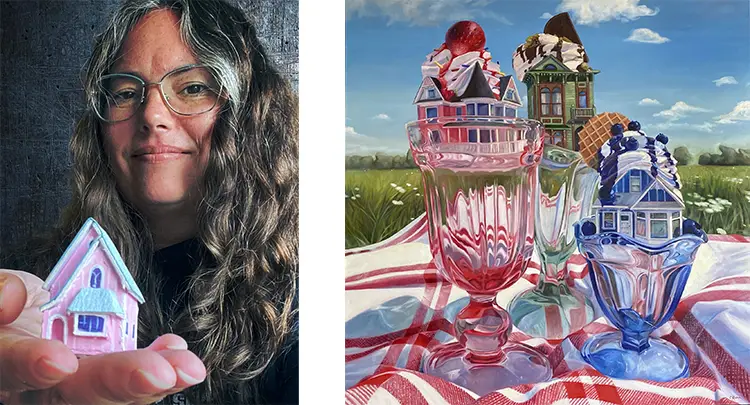
Crystal Rassi: Painting the Weight of Absence
Some of Rassi’s most poignant artistic statements arise from personal grief, channeled into works that resonate with a broader cultural consciousness. One such piece, titled Taken, exemplifies her ability to transmute loss into visual language. The painting features a deserted prairie home, precariously balanced atop a regal purple antique chair, set against the backdrop of a freshly harvested field at sunrise. It is a quiet yet powerful composition that speaks volumes. The chair symbolizes dignity and remembrance, while the abandoned house represents the soul of Rassi’s young niece, who died of cancer at age thirteen. The work is as much a farewell as it is a monument.
The imagery in Taken is not purely allegorical—it is also geographically and emotionally anchored in a specific place. The setting is reminiscent of the Canadian prairies where Rassi grew up, where countless derelict homes scatter the horizon, each with untold stories. These structures, while often dismissed as decaying remnants, serve in her paintings as vessels of both collective and personal memory. For prairie dwellers, the painting evokes the quiet sorrow of abandoned histories, stirring questions about the lives once lived within those walls. In this way, Rassi connects her individual experience of loss to a broader dialogue about memory, permanence, and cultural erosion.
Taken is not an anomaly in her portfolio, but rather a touchstone that encapsulates her artistic philosophy. The balance of architectural precision with emotional weight, the juxtaposition of permanence and fragility, and the interplay between physical space and psychological depth are all central to her approach. Her use of symbolism—like the royal purple of the chair—grounds her work in meaning that extends beyond the visible. In Rassi’s hands, buildings become metaphors, furniture transforms into homage, and landscapes offer the stage upon which profound human truths unfold.
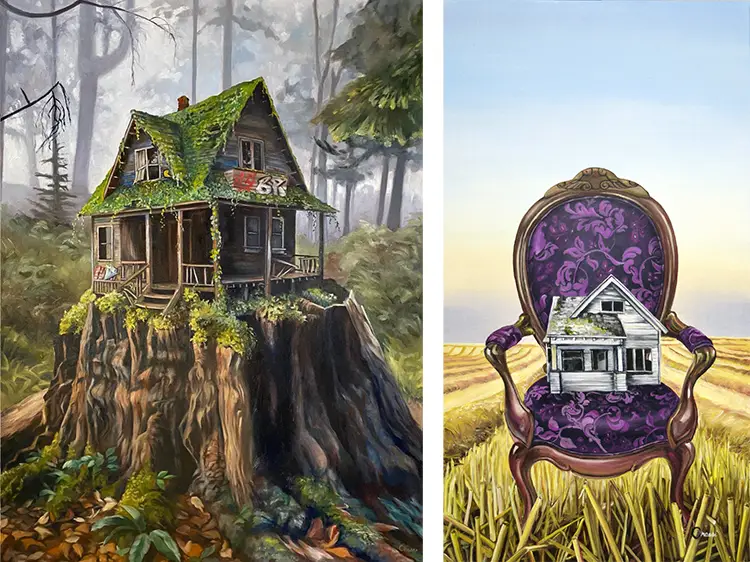
From Structure to Sensibility: A Style Beyond Definition
Rassi resists easy classification when it comes to her artistic style. Her paintings are detailed yet emotionally evocative, toeing the line between realism and conceptual surrealism. Drawing on her background in architectural drafting, she tends toward precise renderings of structures, but tempers this with expressive flourishes reminiscent of impressionist and expressionist traditions. Her compositions are carefully thought through, but her brushwork often reveals spontaneity and emotion. This blend results in work that feels grounded yet dreamlike, technical yet deeply human.
Her creative space, much like her work, is defined by adaptability and intention. Without a dedicated studio, Rassi has cultivated a mobile and efficient practice. Her tools—folding easels, portable palettes, and flexible lighting—allow her to transform any room into a workspace. This pragmatism speaks to her belief in treating art as a profession, even in a small home with multiple demands on space. Her environment reflects not just practicality, but a deep commitment to prioritizing her artistic output. Painting is not an indulgence, but an integral, structured part of her life.
That structure also extends to how she manages creative commitments. She speaks candidly about the importance of saying “no”—to social invitations, to art opportunities that don’t align with her values, and to distractions that pull her from meaningful work. This discernment is not born of rigidity but of clarity. Rassi understands that not every exhibition or call-for-entry supports her artistic identity. She emphasizes the necessity of alignment—of participating only in opportunities that allow her to remain true to her vision. In a culture that often rewards overextension, her approach underscores the value of intentional, purpose-driven practice.
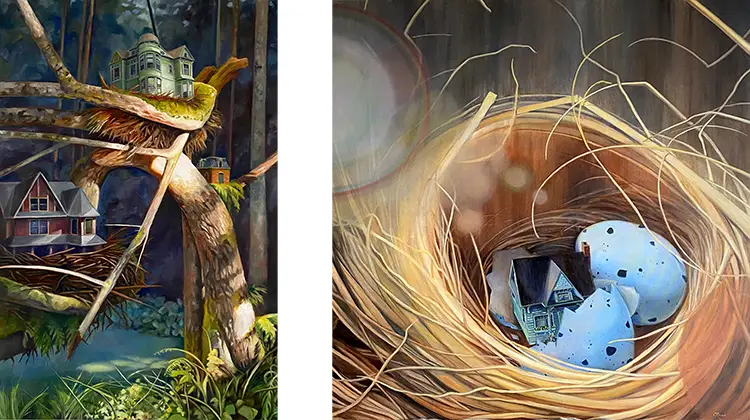
Crystal Rassi: Rooted in Influence, Reaching Toward Legacy
The evolution of Rassi’s practice is shaped in part by a diverse array of mentors and influences who have informed her technique and expanded her conceptual vocabulary. Contemporary illustrators such as Bernie Fuchs, Eyvind Earle, Brent Lynch, and David Dibble have each left a distinct impression. These artists, known for their ability to balance precision with looseness and evoke emotional resonance, mirror Rassi’s own ambitions in her work. They offer models not just of technical mastery but of narrative potency—qualities she continually strives to integrate into her paintings.
Equally significant in her development has been the support and guidance she’s received through Mastrius, where she is both mentor and mentee. The insight offered by mentors like Alex Garant, Greg Newbold, Bryan Larsen, Stephanie Gilcast, and Yong Hong Zong has been transformative. She credits these relationships with accelerating her growth, both artistically and professionally. For Rassi, mentorship isn’t just a stepping stone—it’s a central element of her journey. Her belief in the power of mentorship is evident in her commitment to giving back through the same platform, helping aspiring artists find their path.
Medium choice, too, has been a journey of evolution and rediscovery. Initially trained in acrylics, Rassi worked with them for over fifteen years before switching to oils. The transition was not without hesitation; concerns about toxicity, especially around her children, delayed the shift. But the discovery of safe methods and traditional oil painting techniques reignited her interest. Since 2016, oils have become her primary medium, appreciated for their slower drying time and nuanced blending capabilities. She also enjoys experimenting with watercolor and soft pastels in informal settings—tools she uses to refresh her creativity and explore color without the pressure of formal production. This flexibility in medium reflects her larger artistic ethos: grounded in skill, open to change, and always in pursuit of deeper expression.
